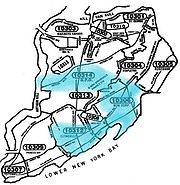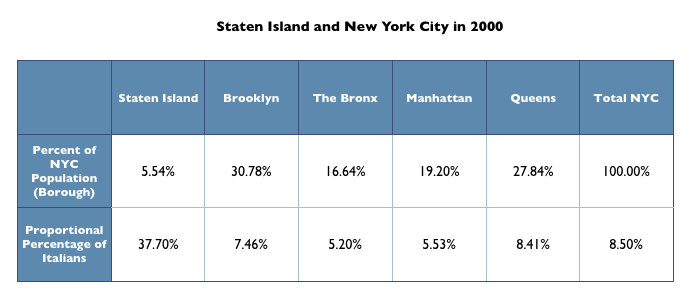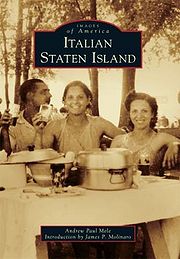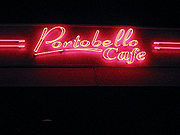From The Peopling of New York City
Contents |
Overview
The Italian community of Staten Island makes up around 40% of the total population of Staten Island; Italians make up the largest ethnic group on Staten Island. The densest concentrations of Italian residents are found in the 10306, 10312, and 10314 zip codes. These zip codes make up the New Dorp/Richmondtown, Eltingville/Annadale, and Castleton Corners/New Springville neighborhoods, respectively. The greatest surge in Italian immigration can be traced back to the late 19th and early 20th centuries.
Demographics
The zip codes which contain the largest Italian population encompass more area than the rest in comparison and higher quantity of housing as a result. Additionally, these areas also have higher average incomes, house value, and greater number of people per household. Upon researching each specific zip code, we discovered a great number of businesses such as pizzerias and contracting firms.
Compiled here is data that compares Staten Island's general population to the other boroughs of New York City, as well as the presence of Italian Americans in each area.
Italian Americans, while making up 37.7% of the Staten Island population, represent a mere 8.5% of the entire population of New York City. Over the course of the twentieth century, the population of Staten Island Italians has increased. In 1980, Italian Americans made up 28.1% of the borough; since then, the population has increased by roughly 9%. In 1990, the population showed an increase of approximately 7%. The Castleton Corners/New Springville neighborhoods (the 10314 zip code) consistently maintains the largest population of ethnically-identifying Italian American residents in all of Staten Island.
History
The Italians' emigration experience was largely influenced by political and social revolutions. Italy, in its early modern stages, was developing politically before the immigration phase of the country’s citizens. Radical social changes affected the quality of life for many Italians, which stirred a desire to emigrate. New World experiences in the United States included clashes in language and competition for work. The Italian Americans clustered into communities, such as the Lower East Side's Little Italy, in order to adjust to the unfamiliar culture. Despite the cultural stereotype, only a small number of Italian immigrants made their way into organized crime, like the Gambino family; instead, the vast majority started their own businesses, and many entered politics.
Prior to the 1870s, there was a relatively small population of Italian Americans in the United States. While Italy attempted to unify all of its city-states, many of its countrymen desired an escape from low incomes and high taxation. Most Italians came to the United States and found employment as unskilled laborers. Although 40% of Italians who came to America returned to Italy with their wages, many stayed in the cities they settled in, such as New York City.
The Italian immigrants had one of the largest surges in population of all ethnic groups between 1870 and 1920, only just eclipsed by the Irish and German populations. Many current Staten Island Italians have roots in ethnically Italian neighborhoods in Brooklyn, but relocated to Staten Island over time (especially after the opening of the Verrazano Narrows Bridge in 1964 linked the two boroughs).
The People
The members of the local Italian population on Staten Island are composed of first, second, and third generation Italian Americans.
Annamarie Leone's family came to Staten Island 32 years ago; originally, she and her family settled down in Brooklyn, New York. She moved from her neighborhood due to a rise in gang related violence, which was unfortunately caused by the clash of old and new immigrant groups in the community. She describes her family's immigration as a gradual process -- her grandmother left for America before her children to settle, and sent for her children a few at a time. She illustrates how she preserves Italian culture through traditions, be it through food or holidays, while adapting to an American lifestyle.
Guy Gioeli is a first generation Italian American. His parents arrived in the United States after facing difficulties in their home country; they chose to come to America because his paternal grandfather had already settled. His parents moved to an immigrant community in the West End of Brooklyn, where his father prospered in business ventures. Gioeli relocated to Staten Island; he describes the Italian community as "close knit, very organized when it comes to business...but they mixed in very well with the American community." In regards to maintaining Italian culture, he explains that he spoke Italian growing up; today, with his own children, they stay true to the culture through means of ethnic food ways, as well as watching and enjoying Italian soccer.
Grace Diaco-Horn came to the United States by ship with family at the age of nine; her father arrived in America at a previous date. Her family settled in Brooklyn, but she did not move to Staten Island until she was married. She recalls her expectations of America as "the end all and be all because [we] heard stories of wonderful adventures and wonderful economic prospects...". She acknowledges that she struggled with the transition because of language, but cites language and education as keys to success in the United States.
Ethnic Stages
"Ethnic Stages" refers to the locations on Staten Island or within the community on which people display their community membership and identity. This can mean churches, community centers, specialized stores with products from the home country, restaurants that serve the community's cuisine, or other sorts of institutions.
Portobello Cafe is an Italian restaurant located on Hylan Boulevard in the Great Kills area of Staten Island. Opened in 1996, the establishment emphasizes the use of portobello mushrooms in several of its dishes. Portobello Cafe serves a variety of food from numerous regions of Italy. It retains several aspects of Italian culture, all while embracing several American ideas and features.
Readings
Buonomo, Leonardo. Backward Glances: Exploring Italy, Reinterpreting America (1831-1866). Madison, NJ: Fairleigh Dickinson UP, 1996. Print.
Carnevale, Nancy C. A New Language, a New World: Italian Immigrants in the United States, 1890-1945. Urbana: University of Illinois, 2009. Print.
Crispino, James A. The Assimilation of Ethnic Groups : the Italian Case. 1st ed. Staten Island: Center for Migration Studies, 1980. Print.
Davis, John A. Naples and Napoleon Southern Italy and the European Revolutions, 1780-1860. Oxford: Oxford UP, 2007. Print.
Glazer, Nathan, and Daniel P. Moynihan. Beyond the Melting Pot: the Negroes, Puerto Ricans, Jews, Italians, and Irish of New York City. Cambridge, Mass.: M.I.T., 1995. Print.
Kessner, Thomas. The Golden Door: Italian and Jewish Immigrant Mobility in New York City, 1880-1915. New York: Oxford UP, 1977. Print.
Mangione, Jerre Gerlando., and Ben Morreale. La Storia: Five Centuries of the Italian American Experience. New York: HarperCollins, 1992. Print.
Richards, David A. J. Italian American the Racializing of an Ethnic Identity. New York: New York UP, 1999. Print.
Santoro, Daniel, and John A. Rallo. Italians: past and Present. New York: Staten Island Italian Historical Society, 1955. Print.
Special Issue: the Italian Experience in Emigration. Staten Island, N.Y.: Center for Migration Studies, 1967. Print.
The Staten Island Italian-American Experience. New York: [s.n.], 2007. Print.
Terpstra, Nicholas. The Politics of Ritual Kinship: Confraternities and Social Order in Early Modern Italy. Cambridge: Cambridge University, 2000. Print.
Tomasi, Lydio F. The Italian American Family; the Southern Italian Family's Process of Adjustment to an Urban America. Staten Island, N.Y.: Center for Migration Studies, 1972. Print.
Tomasi, Silvano M. Perspectives in Italian Immigration and Ethnicity. New York: Center for Migration Studies, 1982. Print.
Tomasi, Silvano M. Piety and Power: the Role of the Italian Parishes in the New York Metropolitan Area, 1880-1930. 1st ed. Staten Island, N.Y.: Center for Migration Studies, 1975. Print.
Woolf, S. J. A History of Italy, 1700-1860: the Social Constraints of Political Change. London: Methuen, 1979. Print.






